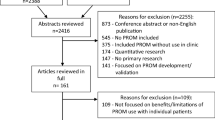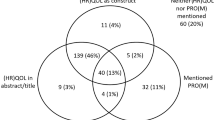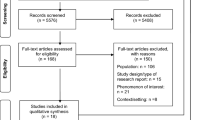Abstract
Purpose
Providing care to patients nearing the end of life can place a considerable burden on caregivers. Hence, policy decisions on interventions in palliative care should be guided by information on this burden. This study investigates construct validation of two preference-based caregiver outcome instruments suitable for economic evaluations: the Carer Experience Scale (CES) and the Care-related Quality of Life (CarerQol) instrument. Moreover, this study reports caregiver experiences in end-of-life care.
Methods
Data were collected with written questionnaires among caregivers of patients receiving palliative care services in the Southern metropolitan area of Adelaide, South Australia (n = 97). The effect of caregiving on caregivers was measured with the CES, CarerQol, Process Utility (PU) and Caregiver Strain Index (CSI). Convergent, discriminative and clinical validity were studied.
Results
As hypothesized, higher negative effect of caregiving measured on the CES was associated with higher negative effect on the CarerQol. Both the CES and CarerQol were associated in the expected positive direction with less strain from caregiving (CSI), more positive care experiences and more PU from caring. Caregivers’ and care recipients’ health status and duration of caregiving were negatively associated with caring experiences.
Conclusions
Our findings suggest that the CES and CarerQol validly assess the effect of caregiving on caregivers in end-of-life care. Economic evaluations in end-of-life care should attempt to incorporate such instruments to provide a more holistic assessment of the true impact of interventions, especially where family and friends are heavily involved in caregiving.




Similar content being viewed by others
Notes
We refer to informal caregivers as ‘caregivers’ in this paper. Professional care is described as ‘formal care’.
One respondent returned an empty questionnaire, and the other did not define themselves as a caregiver.
References
Bobinac, A., Van Exel, N. J., Rutten, F. F., & Brouwer, W. B. (2010). Caring for and caring about: Disentangling the caregiver effect and the family effect. Journal of Health Economics, 29(4), 549–556.
Bobinac, A., van Exel, N., Rutten, F. F. H., & Brouwer, W. B. F. (2011). Health effects in significant others. Medical Decision Making, 31(2), 292.
Schulz, R., Mendelsohn, A. B., Haley, W. E., Mahoney, D., Allen, R. S., Zhang, S., et al. (2003). End-of-life care and the effects of bereavement on family caregivers of persons with dementia. New England Journal of Medicine, 349(20), 1936–1942.
Proot, I. M., Abu-Saad, H. H., Crebolder, H. F., Goldsteen, M., Luker, K. A., & Widdershoven, G. A. (2003). Vulnerability of family caregivers in terminal palliative care at home; balancing between burden and capacity. Scandinavian Journal of Caring Sciences, 17(2), 113–121.
Waldrop, D. P., Kramer, B. J., Skretny, J. A., Milch, R. A., & Finn, W. (2005). Final transitions: Family caregiving at the end of life. Journal of Palliative Medicine, 8(3), 623–638.
Zapart, S., Kenny, P., Hall, J., Servis, B., & Wiley, S. (2007). Home-based palliative care in Sydney, Australia: The carer’s perspective on the provision of informal care. Health and Social Care in the Community, 15(2), 97–107.
Grunfeld, E., Coyle, D., Whelan, T., Clinch, J., Reyno, L., Earle, C. C., et al. (2004). Family caregiver burden: Results of a longitudinal study of breast cancer patients and their principal caregivers. Canadian Medical Association Journal, 170(12), 1795–1801.
Given, B., Wyatt, G., Given, C., Sherwood, P., Gift, A., DeVoss, D., et al. (2004). Burden and depression among caregivers of patients with cancer at the end of life. Oncology Nursing Forum, 31(6), 1105–1117.
Corà, A., Partinico, M., Munafò, M., & Palomba, D. (2012). Health risk factors in caregivers of terminal cancer patients: A pilot study. Cancer Nursing, 35(1), 38–47.
Currow, D. C., Burns, C., Agar, M., Phillips, J., McCaffrey, N., & Abernethy, A. P. (2011). Palliative caregivers who would not take on the caring role again. Journal of Pain and Symptom Management, 41(4), 661–672.
Teno, J. M., Clarridge, B. R., Casey, V., Welch, L. C., Wetle, T., Shield, R., et al. (2004). Family perspectives on end-of-life care at the last place of care. JAMA: The Journal of the American Medical Association, 291(1), 88–93.
Andershed, B. (2006). Relatives in end-of-life care—part 1: A systematic review of the literature the five last years, January 1999–February 2004. Journal of Clinical Nursing, 15(9), 1158–1169.
Ratcliffe, J., Lester, L. H., Couzner, L., & Crotty, M. (2013). An assessment of the relationship between informal caring and quality of life in older community-dwelling adults–more positives than negatives? Health and Social Care in the Community, 21(1), 35–46.
Kang, J., Shin, D. W., Choi, J. E., Sanjo, M., Yoon, S. J., Kim, H. K., et al. (2013). Factors associated with positive consequences of serving as a family caregiver for a terminal cancer patient. Psycho-oncology, 22, 564–571.
McGuire, D. B., Grant, M., & Park, J. (2012). Palliative care and end of life: The caregiver. Nursing Outlook, 60(6), 351–356.
Mularski, R. A., Dy, S. M., Shugarman, L. R., Wilkinson, A. M., Lynn, J., Shekelle, P. G., et al. (2007). A systematic review of measures of end-of-life care and its outcomes. Health Services Research, 42(5), 1848–1870.
Ringdal, G. I., Jordhøy, M. S., & Kaasa, S. (2002). Family satisfaction with end-of-life care for cancer patients in a cluster randomized trial. Journal of Pain and Symptom Management, 24(1), 53–63.
Teno, J. M. (2005). Measuring end-of-life care outcomes retrospectively. Journal of Palliative Medicine, 8(Supplement 1), s-42–s-49.
Aoun, S., Bird, S., Kristjanson, L. J., & Currow, D. (2010). Reliability testing of the FAMCARE-2 scale: Measuring family carer satisfaction with palliative care. Palliative Medicine, 24(7), 674–681.
Gough, K., & Hudson, P. (2009). Psychometric properties of the Hospital Anxiety and Depression Scale in family caregivers of palliative care patients. Journal of Pain and Symptom Management, 37(5), 797–806.
Van Exel, J., Bobinac, A., Koopmanschap, M., & Brouwer, W. (2008). The invisible hands made visible: Recognizing the value of informal care in healthcare decision-making. Expert review of Pharmacoeconomics & Outcomes Research, 8(6), 557–561.
Van Exel, J., de Graaf, G., & Brouwer, W. (2008). Give me a break! Informal caregiver attitudes towards respite care. Health Policy, 88(1), 73–87.
Van Exel, N. J., Brouwer, W. B., Van den Berg, B., Koopmanschap, M. A., & Van den Bos, G. A. (2004). What really matters: An inquiry into the relative importance of dimensions of informal caregiver burden. Clinical Rehabilitation, 18(6), 683–693.
Koopmanschap, M. A., Van Exel, J. N., Van den Berg, B., & Brouwer, W. B. (2008). An overview of methods and applications to value informal care in economic evaluations of healthcare. Pharmacoeconomics, 26(4), 269–280.
Steinhauser, K. E. (2005). Measuring end-of-life care outcomes prospectively. Journal of Palliative Medicine, 8(supplement 1), s-30–s-41.
van Campen, C., de Boer, A. H., & Iedema, J. (2013). Are informal caregivers less happy than noncaregivers? Happiness and the intensity of caregiving in combination with paid and voluntary work. Scandinavian Journal of Caring Sciences, 27, 44–50.
Brouwer, W. B. F., Van Exel, N. J. A., & Tilford, M. J. (2010). Incorporating caregiver and family effects in economic evaluations of child health. In W. J. Ungar (Ed.), Economic evaluation in child health. Oxford: Oxford University Press.
Deeken, J. F., Taylor, K. L., Mangan, P., Yabroff, K. R., & Ingham, J. M. (2003). Care for the caregivers: A review of self-report instruments developed to measure the burden, needs, and quality of life of informal caregivers. Journal of Pain and Symptom Management, 26(4), 922–953.
Van Exel, N. J., Scholte op Reimer, W. J., Brouwer, W. B., Van den Berg, B., Koopmanschap, M. A., & Van den Bos, G. A. (2004). Instruments for assessing the burden of informal caregiving for stroke patients in clinical practice: A comparison of CSI, CRA, SCQ and self-rated burden. Clinical Rehabilitation, 18(2), 203–214.
Van Durme, T., Macq, J., Jeanmart, C., & Gobert, M. (2012). Tools for measuring the impact of informal caregiving of the elderly: A literature review. International Journal of Nursing Studies, 49(4), 490–504.
Travis, S. S., Bernard, M. A., McAuley, W. J., Thornton, M., & Kole, T. (2003). Development of the family caregiver medication administration Hassles scale. The Gerontologist, 43(3), 360–368.
Robinson, B. C. (1983). Validation of a Caregiver Strain Index. Journal of Gerontology, 38(3), 344–348.
Given, C. W., Given, B., Stommel, M., Collins, C., King, S., & Franklin, S. (1992). The caregiver reaction assessment (CRA) for caregivers to persons with chronic physical and mental impairments. Research in Nursing & Health, 15(4), 271–283.
Cameron, J. I., Franche, R., Cheung, A. M., & Stewart, D. E. (2002). Lifestyle interference and emotional distress in family caregivers of advanced cancer patients. Cancer, 94(2), 521–527.
Salmon, J. R., Kwak, J., Acquaviva, K. D., Egan, K. A., & Brandt, K. E. (2005). Validation of the caregiving at life’s end questionnaire. American Journal of Hospice and Palliative Medicine, 22(3), 188–194.
Ferrario, S. R., Baiardi, P., & Zotti, A. M. (2004). Update on the Family Strain Questionnaire: A tool for the general screening of caregiving-related problems. Quality of Life Research, 13(8), 1425–1434.
Zarit, S. H., Reever, K. E., & Bach-Peterson, J. (1980). Relatives of the impaired elderly: Correlates of feelings of burden. The Gerontologist, 20(6), 649–655.
National Institute for Clinical Excellence (NICE). (2008). Guide to the methods of technology appraisal. London.
Pharmaceutical Benefits Advisory Committee. (2013). Guidelines for preparing submissions to the Pharmaceutical Benefits Advisory Committee (Version 4.4).
Brouwer, W. B., & Koopmanschap, M. A. (2000). On the economic foundations of CEA. Ladies and gentlemen, take your positions! Journal of Health Economics, 19(4), 439–459.
Gold, M. R., Siegel, J. E., Russell, L. B., & Weinstein, M. (1996). Cost-effectiveness in health and medicine. New York: Oxford University Press.
Brouwer, W. B., Van Exel, N. J., Van den Berg, B., Van den Bos, G. A., & Koopmanschap, M. A. (2005). Process utility from providing informal care: The benefit of caring. Health Policy, 74(1), 85–99.
Al-Janabi, H., Coast, J., & Flynn, T. N. (2008). What do people value when they provide unpaid care for an older person? A meta-ethnography with interview follow-up. Social Science and Medicine, 67(1), 111–121.
Al-Janabi, H., Flynn, T. N., & Coast, J. (2011). Estimation of a preference-based Carer Experience Scale. Medical Decision Making, 3(3), 458–468.
Brouwer, W. B., Van Exel, N. J., Van Gorp, B., & Redekop, W. K. (2006). The CarerQol instrument: A new instrument to measure care-related quality of life of informal caregivers for use in economic evaluations. Quality of Life Research, 15(6), 1005–1021.
Hoefman, R. J., Van Exel, N. J. A., Rose, J. M., Lawerman-van de Wetering, E. J., & Brouwer, W. B. F. (2014). A discrete choice experiment to obtain a tariff for valuing informal care situations measured with the CarerQol instrument. Medical Decision Making, 34(1), 84–96.
Hoefman, R. J., Van Exel, N. J. A., & Brouwer, W. B. F. (2011). iVICQ. iMTA Valuation of Informal Care Questionnaire. iBMG/iMTA. http://www.bmg.eur.nl/english/imta/publications/questionnaires_manuals/ivicq/. Accessed 02/12 Version 1.1 (December 2013).
Hoefman, R. J., van Exel, J., & Brouwer, W. (2013). How to include informal care in economic evaluations. Pharmacoeconomics, 31(12), 1105–1119.
Goranitis, I., Coast, J., & Al-Janabi, H. (2014). An investigation into the construct validity of the Carer Experience Scale (CES). Quality of Life Research, pp. 1–10.
Hoefman, R. J., Van Exel, N. J. A., Redekop, W. K., Looren-de Jong, S., & Brouwer, W. B. F. (2011). A new test of the validity of the CarerQol instrument: Measuring ‘care-related quality of life’ of informal caregivers for use in economic evaluations. Quality of Life Research, 20(6), 875–887.
Hoefman, R. J., van Exel, N. J. A., Foets, M., & Brouwer, W. B. F. (2011). Sustained informal care: The feasibility, construct validity and test–retest reliability of the CarerQol-instrument to measure the impact of informal care in long-term care. Aging & Mental Health, 15(8), 1018–1027.
Hoefman, R. J., van Exel, J., & Brouwer, W. B. (2013). Measuring the impact of caregiving on informal carers: A construct validation study of the CarerQol instrument. Health and quality of life outcomes, 11(1), 173–186.
EuroQol Group. (1990). EuroQol—a new facility for the measurement of health-related quality of life. Health Policy, 16(3), 199–208.
Viney, R., Norman, R., King, M. T., Cronin, P., Street, D. J., Knox, S., et al. (2011). Time trade-off derived EQ-5D weights for Australia. Value in Health, 14(6), 928–936.
Al-Janabi, H., Frew, E., Brouwer, W., Rappange, D., & Van Exel, J. (2010). The inclusion of positive aspects of caring in the Caregiver Strain Index: Tests of feasibility and validity. International Journal of Nursing Studies, 47(8), 984–993.
Rubio, D. M., Berg-Weger, M., & Tebb, S. S. (1999). Assessing the validity and reliability of well-being and stress in family caregivers. Social Work Research, 23(1), 54–64.
Visser-Meily, J. M., Post, M. W., Riphagen, I. I., & Lindeman, E. (2004). Measures used to assess burden among caregivers of stroke patients: A review. Clinical Rehabilitation, 18(6), 601–623.
Post, M. W., Festen, H., van de Port, I. G., & Visser-Meily, J. M. (2007). Reproducibility of the Caregiver Strain Index and the caregiver reaction assessment in partners of stroke patients living in the Dutch community. Clinical Rehabilitation, 21(11), 1050–1055.
Streiner, D. L., & Norman, G. R. (2003). Health measurement scales: A practical guide to their development and use. Oxford: Oxford University Press.
Al-Janabi, H. (2009). Measurement and valuation of the caring experience for economic evaluation. Ph.D. Dissertation, University of Bristol.
Hopkins, W. G. (2002). A new view of statistics: Effect magnitudes. http://www.sportsci.org/resource/stats/effectmag.html. Accessed 26-07-2010 2010.
Brazier, J., Ratcliffe, J., Salomon, J. A., & Tsuchiya, A. (2007). Measuring and valuing health benefits for economic evaluation. Oxford; New York: Oxford University Press.
Al-Janabi, H., Flynn, T. N., & Coast, J. (2011). QALYs and carers. Pharmacoeconomics, 29(12), 1015–1023.
Burns, C. M., Abernethy, A. P., Dal Grande, E., & Currow, D. C. (2013). Uncovering an invisible network of direct caregivers at the end of life: A population study. Palliative Medicine, 27(7), 608–615.
Wittenberg, E., Ritter, G. A., & Prosser, L. A. (2013). Evidence of spillover of illness among household members EQ-5D Scores from a US sample. Medical Decision Making, 33(2), 235–243.
Holmes, A. M., & Deb, P. (2003). The effect of chronic illness on the psychological health of family members. Journal of Mental Health Policy and Economics, 6(1), 13–22.
Teno, J. M., Casey, V. A., Welch, L. C., & Edgman-Levitan, S. (2001). Patient-focused, family-centered end-of-life medical care: Views of the guidelines and bereaved family members. Journal of Pain and Symptom Management, 22(3), 738–751.
Acknowledgments
We would like to thank the caregivers who participated in our study. Moreover, we would like to thank Kate Swetenham, Service Director of Southern Adelaide Palliative Services and Aine Greene, Clinical Trials Manager, Southern Adelaide Palliative Services, for their assistance with survey administration and data collection.
Author information
Authors and Affiliations
Corresponding author
Rights and permissions
About this article
Cite this article
Hoefman, R., Al-Janabi, H., McCaffrey, N. et al. Measuring caregiver outcomes in palliative care: a construct validation study of two instruments for use in economic evaluations. Qual Life Res 24, 1255–1273 (2015). https://doi.org/10.1007/s11136-014-0848-8
Accepted:
Published:
Issue Date:
DOI: https://doi.org/10.1007/s11136-014-0848-8




